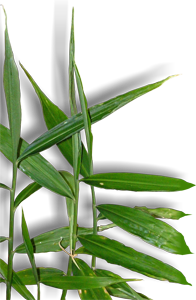Herbs - Medicinal Plants
Ginger root. Properties of the Ginger plant.
Identification and origin of Ginger

Scientific name: Zingiber officinale
Other names: Ginger root, Zingiberaceae, Jamaican Ginger, African Ginger, Ancoas.
Ginger is a herbaceous plant up to 90 cm with horizontal rhizome, leaves linear - lanceolate 18-28 cm long, sessile, acuminate. Peduncle of 15 to 25 cm; ellipsoid spikes of 4 to 6 cm; egg-shaped suborbicular bracts, hairy; purple corolla, tube of 2 cm. Capsules of 3 valves, opening irregularly. There are different cultivars. Parts used: rhizomes.
Ginger root active ingredients and content

The rhizome of ginger contains:
Essential oil consisting of monoterpenes (camphene, neral, citronellal, 1,8-cineole, beta-phellandrene, camphor, geranial, borneol, linalool) and sesquiterpenes (zingiberene, zingiberol, B-eudesmol, curcumene, beta-bisabolene, beta-bisabolone , (EE)-alfa-farnesene, elemol, beta-sesquifelandrene, furanogermenone). Sesquiterpenes are responsible for the scent.
References
- Thomas S.C. Li. Chinese and Related North Amercian Herbs Phytopharmacology and Therapeutic Values. 202 by CRC Press LLc.
- Ravindran, P.N. and Nirmal Babu, K. Ginger. The Genus Zingiber. Medicinal and Aromatic Plants Industrial Profiles. 2005 by CRC Press.
- WHO monographs on selected medicinal plants. VOLUME 1. World Health Organization. Geneva 1999.
- Duke, J.A.; Bogenschutz – Godwin, M.J.; duCellier, J.; Duke, P-R. CRC Handbook of Medicinal Spices 2003 by CRC Press LLC
- Bisset NG (ed). Herbal Drugs and Phytopharmaceuticals; a Handbook for Practice on a Scientific Basis. Medpharm Scientific Publishers, Stuttgart and CRC Press, Boca Raton, 1994.
- Bone ME, Wilkinson DJ, Young JR et al.. Ginger root- a new antiemetic. The effect of ginger root on postoperative nausea and vomiting after major gynecological surgery. Anaesthesia 45:669-71. 1990.
- Bracken J, Ginger as an antiemetic: possible side effects due to its thromboxane synthetase activity. Anaesthesia; 46:705-706. 1991.
- Chang CP, Chang JY, Wang FY et al.. The effect of Chinese medicinal herb Zingiberis rhizoma extract on cytokine secretion by human peripheral blood mononuclear cells. J Ethnopharmacol 48:13-19. 1995.

 Pharmacognosy´s topics - Medicinal plants
Pharmacognosy´s topics - Medicinal plants































Write a comment